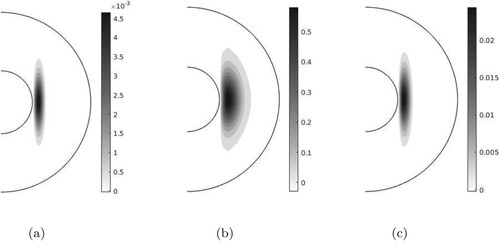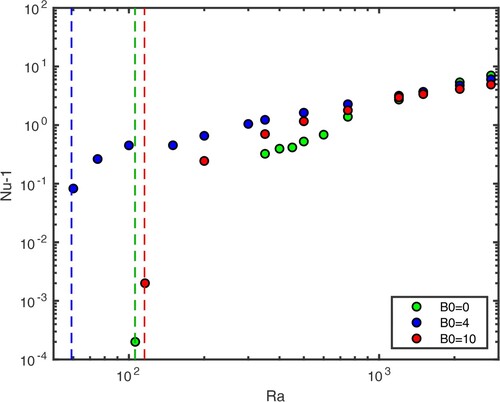 ?Mathematical formulae have been encoded as MathML and are displayed in this HTML version using MathJax in order to improve their display. Uncheck the box to turn MathJax off. This feature requires Javascript. Click on a formula to zoom.
?Mathematical formulae have been encoded as MathML and are displayed in this HTML version using MathJax in order to improve their display. Uncheck the box to turn MathJax off. This feature requires Javascript. Click on a formula to zoom.ABSTRACT
We report simulations of thermal convection and magnetic-field generation in a rapidly-rotating spherical shell, in the presence of a uniform axial magnetic field of variable strength. We consider the effect of the imposed field on the critical parameters (Rayleigh number, azimuthal wavenumber and propagation frequency) for the onset of convection, and on the relative importance of Coriolis, buoyancy and Lorentz forces in the resulting solutions. The imposed field strength must be of order one (corresponding to an Elsasser number of unity) to observe significant modifications of the flow; in this case, all the critical parameters are reduced, an effect that is more pronounced at small Ekman numbers. Beyond onset, we study the variations of the structure and properties of the magnetically-modified convective flows with increasing Rayleigh numbers. In particular, we note the weak relative kinetic helicity, the rapid breakdown of the columnarity, and the enhanced heat transport efficiency of the flows obtained for imposed field strengths of order one. Furthermore, magnetic and thermal winds drive a significant zonal flow in this case, which is not present with no imposed field or with stronger imposed fields. The mechanisms for magnetic field generation (particularly the lengthscales involved in the axisymmetric field production) vary with the strength of the imposed field, with three distinct regimes being observed for weak, order one, and stronger imposed fields. In the last two cases, the induced magnetic field reinforces the imposed field, even exceeding its strength for large Rayleigh numbers, which suggests that magnetically-modified flows might be able to produce large-scale self-sustained magnetic field. These magnetoconvection calculations are relevant to planets orbiting magnetically active hosts, and also help to elucidate the mechanisms for field generation in a strong-field regime.
1. Introduction
Planetary magnetic fields are thought to be fundamentally produced by convective motions inside the liquid core of planets via a dynamo process, whereby the kinetic energy of the flow is converted into magnetic energy. Planetary dynamos operate under the major influence of the Coriolis force due to the rapid rotation of the planet. Magnetic fields can also significantly affect the convective flows via a magnetic feedback force, the Lorentz force. The relative strengths of the Lorentz and Coriolis forces can be estimated with the Elsasser number (which we will define more precisely in section 2). An Elsasser number of order unity is often interpreted as an indication that both forces play an equally important role on the dynamics. In the Earth's core, the Elsasser number is estimated to be of the order of 10 (Gillet et al. Citation2010), so the geodynamo (and planetary dynamos in general) operate under the major influence of the Lorentz force, in addition to the Coriolis force.
Numerical simulations of convective dynamos aim to provide a better understanding of the core dynamics and the generation of planetary magnetic fields (e.g. Christensen and Wicht Citation2015). Although the governing equations solved by these numerical models are good approximations of the modelled system, the controlling parameters used in the models can vastly differ from realistic values. A well-know example is the problematic Ekman number , which measures the ratio of the rotation period to the viscous timescale at the system size:
is
in the Earth's liquid core, but is typically set to
in numerical models. This artificial increase of the fluid viscosity is necessary to eliminate the small scales that cannot be resolved on the numerical grid. As a result, viscous forces play a more important role in the large-scale dynamics in numerical models than is realistic. Notwithstanding these unavoidable computational limitations, geodynamo simulations are able to reproduce some of the key characteristics of the geomagnetic field such as a mainly dipolar field. But despite this generation of a relatively strong dipolar magnetic field, the detailed role played by the magnetic field on the dynamics often remains unclear and debated (e.g. Soderlund et al. Citation2012, King and Buffett Citation2013, Oruba and Dormy Citation2014, Cheng and Aurnou Citation2016). Recent geodynamo simulations have focussed on exploring the parameter space where the sustained magnetic fields visibly affect the dynamics; these are sometimes termed “strong-field” dynamos, although this term is ambiguous. Different approaches to produce strong-field dynamos have been followed, such as using large values of the magnetic Prandtl number (the ratio of viscosity to magnetic diffusion) at the relatively high Ekman numbers considered by most studies (Dormy Citation2016), or performing computationally intensive simulations with Ekman numbers as low as currently feasible (
) (Yadav et al. Citation2016a, Aubert et al. Citation2017, Schaeffer et al. Citation2017). Changes of the convective flow due to the Lorentz force in these dynamos include a visible increase of the typical flow lengthscale, and the loss of the regular columnar structure of the flow, which is a feature of rotationally-dominated convection.
In this work, we adopt a different approach to examine the influence of magnetic fields on convection by studying magnetoconvection, where a magnetic field is externally imposed on the convective system. The great advantage of magnetoconvection is the ability to control the strength and configuration of the imposed magnetic field precisely. The basis of our knowledge of the effect of large-scale magnetic fields on rotating convection comes from early studies of linear magnetoconvection in a planar domain (Chandrasekhar Citation1961); for instance, a well-known result of planar rotating magnetoconvection is that a uniform vertical magnetic field favours convection for Elsasser numbers of the order of unity, with the emergence of a preferred system-size mode. There have been numerous studies of magnetoconvection in spherical geometries using imposed azimuthal fields (e.g. Cardin and Olson Citation1995, Olson and Glatzmaier Citation1995, Gillet et al. Citation2007), but few using an imposed uniform axial field (Fearn Citation1985, Sarson et al. Citation1997, Sakuraba and Kono Citation2000, Sakuraba Citation2002, Citation2007, Gómez-Pérez and Wicht Citation2010, Teed et al. Citation2015). Here we choose the uniform axial field configuration, firstly because most planetary magnetic fields have a dominant dipolar field at the planet surface, and numerical dynamo simulations show that magnetic fields generated by rotating spherical convection are naturally organised in dipole-dominated configuration (Olson et al. Citation1999, Sreenivasan and Jones Citation2011). Secondly, this configuration is particularly relevant for satellite bodies surrounded by the ambient magnetic fields of their host planets. For example, Io is thought to be able to produce its own field due to the presence of Jupiter's magnetic field providing a strong ambient field (Sarson et al. Citation1997). Thirdly, uniform axial fields are stable (i.e. force-free). Azimuthal magnetic fields are subject to magnetic instabilities that can onset before the convective instabilities for strong imposed field (Fearn and Weiglhofer Citation1991a, Citation1991b, Citation1992a, Citation1992b, Zhang and Fearn Citation1993, Proctor Citation1994, Zhang Citation1995), a situation that we wish to avoid for simplicity.
Linear magnetoconvection in a rotating spherical shell with an imposed uniform axial field was investigated in a numerical study by Sakuraba (Citation2002). He showed the existence of an overall minimum of the critical Rayleigh number (which measures the strength of the buoyancy driving against diffusive effects) for Elsasser number of the order unity, similarly to the case of magnetoconvection in the presence of a uniform toroidal magnetic field (Fearn Citation1979). CitationSakuraba found that a variety of convective modes can be unstable, depending on the strength of the imposed magnetic field. As the Elsasser number is increased, geostrophic, magneto-geostrophic and magnetostrophic modes are successively preferred at the onset of convection, where these modes are distinguished by the increasing role played by the Lorentz force in the primary force balance. In the nonlinear model of Sarson et al. (Citation1997, Citation1999), which uses a two azimuthal mode approximation, a weak-field solution and a strong-field solution were observed, depending on the strength of the buoyancy forcing. In the latter case, the system essentially behaves like a self-sustained dynamo without being strongly affected by the imposed field. In a study of the fully nonlinear system, Sakuraba and Kono (Citation2000) found that the transition between the two types of solutions occurs abruptly for an Elsasser number of order unity. The transition is characterised by an increase in the kinetic and induced magnetic energies, while the convective cells retain the same azimuthal lengthscale. On the other hand, Gómez-Pérez and Wicht (Citation2010) found that the flow lengthscale visibly increases in the presence of a strong imposed field. Interestingly, Sarson et al. (Citation1997, Citation1999) and Sakuraba and Kono (Citation2000) found evidence of hysteretic behaviour in this system, where the final state depends on the initial condition. The present paper follows on from these earlier studies and aims to investigate the modification of the convective flows in the presence of a strong magnetic field and, in particular, the morphology of the magnetic fields that these modified flows induce.
Dynamos driven by planar rotating convection can produce strong large-scale magnetic fields that disturb the small-scale convective flows and lead to the emergence of box-size flows (Stellmach and Hansen Citation2004, Cooper et al. Citation2020). These box-size flows are not able to sustain large-scale magnetic fields themselves, leading to intermittent dynamo behaviour, where the system fluctuates between strong-field and weak-field states. This intermittent behaviour has not been reported so far in spherical dynamo simulations with strong fields (e.g. Dormy Citation2016, Schaeffer et al. Citation2017). By studying whether magnetically-modified flows can induce large-scale magnetic fields, we can speculate whether an intermittent behaviour might be expected in spherical dynamos. Using spherical magnetoconvection results, Zhang and Gubbins (Citation2000a, Citation2000b) previously suggested that this behaviour might indeed be relevant for the geodynamo.
The linear magnetoconvection study of Sakuraba (Citation2002) shows that the relatively large Ekman number adopted in previous nonlinear studies () misses some of the complexity of the linear convective modes observed at smaller
(
). Furthermore, fully nonlinear studies were carried out in the moderately supercritical regime (with Rayleigh numbers less than twice the critical value at onset). We will therefore model magnetoconvection for values of
that allow us both to study the rich small-
dynamics and to explore widely the supercritical regime (with Rayleigh numbers up to 50 times the critical value).
The layout of the paper is as follows. The mathematical and numerical formulation of the model is described in section 2. In section 3, we present the effects of the imposed magnetic field on the onset of convection. We discuss the evolution of the flow properties in section 4, including changes in the efficiency of the convective heat transfer and the formation of zonal flows. The characteristics of the induced magnetic field and the generation of the axisymmetric field are presented in section 5. Finally, we discuss the significance of our results in section 6.
2. Equations and methodology
2.1. Governing equations
We study thermal Boussinesq convection in a rotating spherical shell in the presence of an externally imposed magnetic field. The convection is driven by imposing a temperature difference between the inner sphere at radius
and the outer sphere at radius
. The aspect ratio is set to
. The system rotates at the rotation rate Ω about the z-axis. Gravity varies linearly in radius,
. The imposed magnetic field is uniform and axial,
. This is implemented via a boundary condition, as described in section 2.2. We use
as the unit of length. The computational domain is therefore located between
and
. Times are scaled by
, the velocity
by
, the temperature T by
, the magnetic field
by
, and the pressure P by
, where ρ is the density, ν the kinematic viscosity, η the magnetic diffusivity, and μ the magnetic permeability. The dimensionless governing equations are
(1)
(1)
(2)
(2)
(3)
(3)
(4)
(4)
(5)
(5)
where
is the total magnetic field comprised of both the imposed and induced parts, and
is the electric current density. The dimensionless parameters are the Ekman number
(6)
(6)
the Rayleigh number
(7)
(7)
the Prandtl number
(8)
(8)
and the magnetic Prandtl number
(9)
(9)
where κ is the thermal diffusivity and α the thermal expansion coefficient. In all our simulations,
and
are kept fixed to 1. Note that we use the definition of the Rayleigh number from the dynamo benchmark (Christensen et al. Citation2001), which is related to the traditional definition of the Rayleigh number,
, by
.
The boundary conditions are fixed temperature, electrically insulating, no-slip and impenetrable at and
.
2.2. Numerical method
All our simulations are performed using the code PARODY, which was originally written by Dormy et al. (Citation1998), and subsequently modified, parallelised and optimised by J. Aubert and E. Dormy (e.g. Aubert et al. Citation2008, Dormy Citation2016). PARODY is a Fortran pseudo-spectral code that solves the magnetohydrodynamic equations (Equation1(1)
(1) )–(Equation5
(5)
(5) ) for a Boussinesq fluid in a 3D spherical geometry. The code was previously benchmarked against five independent numerical codes used in the geodynamo community (Christensen et al. Citation2001). The velocity and magnetic fields are decomposed into poloidal and toroidal scalars, which are then expanded in spherical harmonics
in the angular coordinates, with l the degree and m the order. A second-order finite difference scheme is used on an irregular radial grid, which is finer near the boundaries and uses a geometrical progression for the radial increment. A Crank-Nicolson scheme is implemented for the time integration of the diffusion terms and an Adams-Bashforth procedure is used for the other terms. The poloidal-toroidal decomposition and the spherical geometry allow a relatively simple implementation of the magnetic boundary conditions. We use the SHTns library for the spherical harmonic transforms (Schaeffer Citation2013). The numerical resolution used for each simulation is given in table in appendix C.
We have modified the code to include an externally imposed magnetic field. The imposed field is axial and uniform, , and so, it only has a poloidal component that projects on the spherical harmonic
. The field is imposed by modifying the boundary condition at
for this specific harmonic of the poloidal magnetic field, giving
(10)
(10)
where
gives the spectral coefficient of the poloidal magnetic field of degree l = 1 and order m = 0 at radius r. The derivation of this boundary condition is given in appendix A.
For the initial condition, a small perturbation is added to all the spectral coefficients of the temperature field. All the other fields are set to zero, except in the case of no imposed magnetic field (), where the magnetic field is initialised by an axial dipole and a toroidal field of harmonic
, both of amplitude of order unity in the dimensionless unit.
2.3. Definitions of the output quantities
The Elsasser number is often used in dynamo studies to estimate the ratio of the Lorentz force to the Coriolis force. It is defined as
(11)
(11)
where B is a r.m.s. measure of the magnetic intensity in dimensional form. In our units,
, where the dimensionless r.m.s. magnetic intensity is
, with
the volumetric (dimensionless) magnetic energy density in the fluid shell. To quantify the strength of the imposed field, we will quote values of
. Previous studies (e.g. Sakuraba Citation2002) use instead the Elsasser number based on
, which is simply
.
To measure the ratio of the kinetic to magnetic energies, we use the squared Alfvén number (Aubert et al. Citation2017)
(12)
(12)
where U is the r.m.s. velocity in dimensional form. (This can also be identified as the square of the ratio of the fluid velocity to the Alfvén velocity.) In our units,
, where the dimensionless r.m.s. velocity is
, with
the volumetric kinetic energy.
We define the Reynolds number of the convective flow as
(13)
(13)
where
is the volumetric (dimensionless) kinetic energy density based on the poloidal velocity, and
is a time average taken over at least one third of a viscous timescale.
The magnetic Reynolds number is defined as .
The efficiency of the convective heat transfer is usually measured by the Nusselt number , which is the ratio of the total heat flux to the conducted heat flux in the absence of convection. In our system,
is calculated at the outer boundary and is
(14)
(14)
where
denotes an average over a spherical surface,
is the conducted heat flux at
, and T is the total temperature, which includes the static background temperature. (The conducted heat flux is simply the negative of the radial derivative of the static background temperature.)
Selected output values from our simulations are given in table in appendix C. A complete list and the numerical resolution is given in Data.xlsx to be found in the supplementary material.
3. Onset of magnetoconvection
3.1. Critical parameters
We first examine the effect of the imposed axial field on the three critical parameters at the onset of convection: the critical Rayleigh number , the marginally stable azimuthal wavenumber
, and the frequency of the marginally stable mode
. The onset of convection is determined numerically using PARODY by observing the growth rate of the kinetic energy of each azimuthal wavenumber at given
. The critical parameters are given in tables – for
and
. In table for
, we compare
(which we denote
hereafter) and
with the theoretical values obtained from the asymptotic analysis of Dormy et al. (Citation2004) in the case of non-magnetic rotating convection with differential heating in a spherical shell with
and no-slip boundaries. In the asymptotic theory,
and
both scale as
in the leading order asymptotics. Note that we have used the relevant scaling factor to account for the different definitions of the Ekman and Rayleigh numbers (recall in particular that
in our definition). The agreement between numerical and theoretical values is good and reduces when
decreases, as expected. Figure (a) shows
as a function of
. We find that
must be greater than 1 to significantly influence the onset of convection for both Ekman numbers. As
increases above unity,
first decreases and reaches a minimum at
for
and at
for
. The decrease in
is significant, reaching a minimum of
for
and
for
. The decrease of
is accompanied by a decrease of
, which is most noticeable at the smallest
, as seen in figure (b). At larger
,
increases, reaching a value that is approximately independent of
and larger than
for both
. This increase is accompanied by an increase in
, which is again most noticeable at the smallest
.
Figure 1. (a) Critical Rayleigh number , and (b) azimuthal wavenumber
, as a function of the imposed magnetic field strength
for
and
. (Colour online)
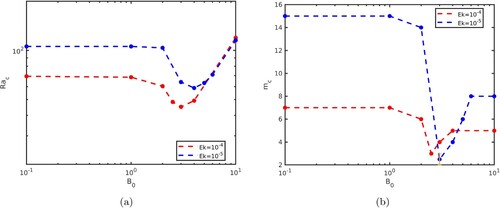
Table 1. Critical Rayleigh number and azimuthal wavenumber
obtained in our simulations for varying
and
.
Table 2. Frequency ω of the dominant mode for simulations at
just above
compared with the theoretical value of the non-magnetic thermal Rossby waves,
, calculated for the mode
in the asymptotic study of Dormy et al. (Citation2004) (see appendix B).
The evolution of and
with
is similar to that observed in the linear magnetoconvection study of Sakuraba (Citation2002), which mainly focussed on the case of internal heating with no inner core and zero flux boundary condition at
. The main difference between their results and ours is that CitationSakuraba observed that the preferred mode at the onset is an axisymmetric mode for
. This axisymmetric “polar” mode consists of a large-scale meridional circulation that crosses the equatorial plane and transports heat between the two hemispheres. The absence of this polar mode at the onset in our simulations is presumably due to our choice of inner core size and fixed temperature boundary conditions, as CitationSakuraba shows that the stability curve of the polar mode increases towards larger
in these conditions.
The qualitative behaviour of is also similar to that expected from linear magnetoconvection in rotating planar geometry (Chandrasekhar Citation1961). In the case where rotation vector and imposed magnetic field are vertical,
starts to decrease when
, while the lengthscale of the convection switches to a system-size scale (Roberts and King Citation2013). This change corresponds to a change in the primary force balance from a viscously-dominated regime for
, where the viscous force is needed to break the Proudman-Taylor constraint, to a magnetically-dominated regime, where the Lorentz force becomes sufficiently large to assume this role. For the modest values of
considered here, the regime change is expected to occur around
. In our configuration, we find that the regime change occurs for larger
,
, with no apparent dependence on
. However, our simulations are relatively coarse-grained in
, while
only varies by a decade. We would therefore not be able to pick up an
trend. In planar magnetoconvection, the minimum of
occurs for
and, in the limit
,
scales as
and the critical horizontal wavenumber as
(Roberts and King Citation2013). In our spherical system, we also find that
becomes independent of
at large
, although we have too few data points to check the scaling with
. However, the critical wavenumber retains an
-dependence with no clear dependence on
.
Table gives the frequency ω of the waves at the dominant azimuthal wavenumber for simulations with
just above
. By dominant wavenumber, we mean the wavenumber corresponding to the peak in the power spectrum of the kinetic energy. The frequencies were obtained by calculating the azimuthal drift of the dominant mode in Hovmöller maps (longitude-time maps at a fixed radius in the equatorial plane) of the radial velocity. Note that any azimuthal drift due to the zonal velocity was subtracted to extract the frequency of the waves. The frequency can be compared with the expected frequency of thermal Rossby waves of azimuthal wavenumber
at the onset of non-magnetic convection, which we estimate by using the theoretical values provided by the asymptotic study of Dormy et al. (Citation2004) for our configuration (see appendix B). Outside the tangent cylinder (where the height of the outer sphere decreases outwards), thermal Rossby waves always propagate in the prograde direction and their frequency decreases for increasing azimuthal wavenumber. For
, ω is close to the theoretical frequency of the thermal Rossby waves. For
, ω is much slower than the frequency of the thermal Rossby waves, indicating that the Lorentz force plays a significant role in the propagation mechanism. Near the minimum of
(
and 4 for
and
respectively), the increase of the frequency of the dominant mode
when
decreases is relatively weak compared with the increase expected for the thermal Rossby wave (scaling as
in the leading order asymptotics, see appendix B). For
at
, the wave propagates in the retrograde direction, revealing the dominance of the Lorentz force (Finlay Citation2008). The force balance in these waves will be analysed in section 3.3 below.
3.2. 3D structure of the flow
Figure shows the 3D isosurfaces of the radial velocity for selected
with
just above the onset of convection for
and
. For each
, the three cases were chosen to represent the viscously-dominated regime (
) and the field-dominated regimes at the minimum of the
stability curves (
or 4) and at large
(
). In all cases, the convective flow is mainly columnar. For
, we observe the well-known structure of thermal Rossby waves with a tilt of the column in the prograde direction (Zhang Citation1992). For
, the flow adopts a banana shape with a visible z-dependence, especially for
. For
, the columns are straight with no tilt. The preservation of the columnar shape of the convection cells for
can explain why the axial magnetic field starts to influence convection for
in our simulations, while studies of spherical magnetoconvection with an imposed azimuthal field find that a smaller field amplitude (
) is sufficient (Fearn Citation1979). In the axial field problem, the magnetic perturbations are created by the distortions of the imposed field due to the z-gradients of the velocity (via the
part of the induction term), as opposed to the azimuthal field problem, where they are mainly due to the ϕ-gradients. For columnar flows, the z-gradients of the velocity are much smaller than the ϕ-gradients, so the effect is only comparable for larger
.
Figure 2. Isosurfaces of for values of
just above the onset of convection (as in table ). The top row shows cases at
and the bottom row at
. The red and blue surfaces correspond to isosurfaces at ±20
of the maximum value of
respectively. (a)
. (b)
. (c)
. (d)
. (e)
and (f)
. (Colour online)
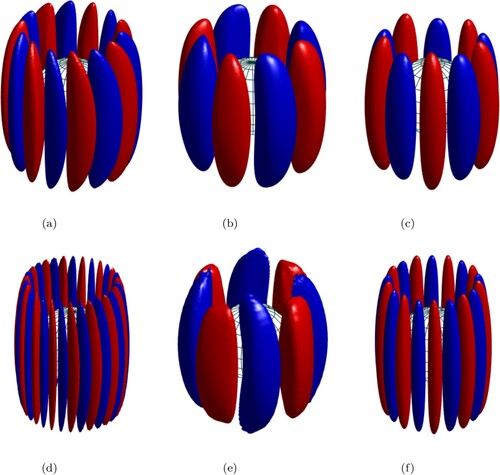
To study the axial structure of the flow, we consider the modified Proudman–Taylor constraint following Sakuraba (Citation2002). Taking the curl of the Navier-Stokes equation (Equation1(1)
(1) ) and assuming that inertia, buoyancy and viscous forces are negligible gives
(15)
(15)
where the nonlinear contributions to the Lorentz force have also been neglected. Since the imposed field is uniform,
is only produced by the induced magnetic field. We define the modified velocity as
(16)
(16)
so that the modified Proudman–Taylor constraint is
.
Figure shows the s-components of ,
and
on the axial cylindrical surface of radius s = 0.7 for the three cases of figure at
. The onset of the dynamo for
occurs at larger
(
) so this case does not have a magnetic field. For
, the contours of
are bent along the z-axis, which gives the banana shape observed in 3D in figure . In this case,
opposes
near the equatorial region, which produces a modified velocity that is fairly z-invariant. The system therefore closely follows the modified Proudman–Taylor constraint (Equation15
(15)
(15) ). For
, both
and
are largely z-invariant, although the deviation from z-invariance is greater near the outer boundary for the velocity. In this case,
is greater near the outer boundary, where it is correlated with
. Interestingly, the axial structure of
for
and 10 is similar to that of
for
, with the maxima of the absolute value located near the outer boundary. This is perhaps logical, given that the increased significance of viscosity in the boundary layers acts to reduce the applicability of the (modified) Proudman–Taylor constraint there, allowing for local variations. Moreover
has a contribution from
, and since the magnetic boundary condition requires the toroidal scalar to go to zero at the outer radius, the maxima of
at the boundary is also unsurprising. The fact that the maxima of
are encountered around the equatorial region rather than near the outer boundaries (for
) has an effect on the convective heat transport, as shown in section 4.2.
Figure 3. Contour plots of (left),
(middle) and
(right) on the axial cylindrical surface (
plane) of cylindrical radius s = 0.7 for the three cases shown in figure for
. For clarity, a restricted azimuthal range is shown; for (a), the azimuthal range is
, for (b)
, and for (c)
. All panels on the same row have the same colorbar. (a)
,
. (b)
,
and (c)
,
. (Colour online)
![Figure 3. Contour plots of us (left), B0/(2Pm)js (middle) and uˆs (right) on the axial cylindrical surface (ϕz plane) of cylindrical radius s = 0.7 for the three cases shown in figure 2 for Ek=10−5. For clarity, a restricted azimuthal range is shown; for (a), the azimuthal range is ϕ∈[0,π/4], for (b) ϕ∈[0,π], and for (c) ϕ∈[0,π/2]. All panels on the same row have the same colorbar. (a) B0=0, Ra=106. (b) B0=4, Ra=60 and (c) B0=10, Ra=116. (Colour online)](/cms/asset/25fd9e29-0e21-4624-ad1b-01286b72dcec/ggaf_a_2107202_f0003_oc.jpg)
3.3. Force balance
To conclude this section, we investigate the dynamical force balance near the onset of convection. To do so, we look at the vorticity equation to eliminate the pressure term. Since the flow is mainly columnar, we consider the equation of the z-component of the vorticity ,
(17)
(17)
where
(18)
(18)
(19)
(19)
(20)
(20)
(21)
(21)
(22)
(22)
Figure shows
and the terms in equations (Equation18
(18)
(18) )–(Equation22
(22)
(22) ) on the axial cylindrical surface of radius s = 0.7 for the three cases of figure at
. The terms are plotted using individual snapshots that are representative of the flow over time. For
, the Coriolis and buoyancy terms are the most significant in the force balance; the viscous term is non-negligible, but is subdominant. Positive buoyancy terms are largely balanced by negative Coriolis terms, both being largest between anticyclones and cyclones (in the prograde direction); with opposite signs, there is a similar balance between cyclones and anticyclones. For
, the Lorentz term is one of the dominant forces, alongside the Coriolis and buoyancy terms (a MAC balance). The Coriolis and Lorentz terms balance each other at higher latitudes, whereas the contribution of the buoyancy term is more relevant near the equatorial region. Here, “sinks” in the buoyancy term are opposed by the Lorentz force, whilst buoyancy “sources” are balanced by the Coriolis force. For
, the force balance is primarily between the buoyancy term and the Lorentz term in the equatorial region (a MA balance), but towards the outer surface the balance is again between Coriolis and Lorentz contributions. The sum of the r.h.s. terms is relatively large for
, consistent with the greater frequency of propagation seen for that case in table . In other words, one effect of the Lorentz force for
is to reduce this prograde propagation, as noted earlier for the frequencies at onset.
Figure 4. Contour plots, from left to right, of: ,
,
,
,
,
, and
=
on the axial cylindrical surface (
plane) of cylindrical radius s = 0.7 for the three cases shown in figure for
. The second to sixth panels on each row have the same colorbar. For clarity, a restricted azimuthal range is shown; for (a), the azimuthal range is
, for (b)
, and for (c)
. 10 radial grid points have been excluded at the outer boundary to highlight the dynamics in the bulk. (a)
,
. (b)
,
and (c)
,
. (Colour online)
![Figure 4. Contour plots, from left to right, of: ωz, IC, IL, IB, IV, IR, and IT=IC+IL+IB+IV+IR on the axial cylindrical surface (ϕz plane) of cylindrical radius s = 0.7 for the three cases shown in figure 2 for Ek=10−5. The second to sixth panels on each row have the same colorbar. For clarity, a restricted azimuthal range is shown; for (a), the azimuthal range is ϕ∈[0,π/4], for (b) ϕ∈[0,π], and for (c) ϕ∈[0,π/2]. 10 radial grid points have been excluded at the outer boundary to highlight the dynamics in the bulk. (a) B0=0, Ra=106. (b) B0=4, Ra=60 and (c) B0=10, Ra=116. (Colour online)](/cms/asset/2eef8f9b-9ceb-4743-8b0e-cd2bf76b7c86/ggaf_a_2107202_f0004_oc.jpg)
4. Evolution of the flow with increasing Rayleigh number
In the rest of paper, we will present results obtained at for varying
. Similar observations can be drawn from the simulations at
; exceptions are discussed in the text. In this section, we study how the presence of the ambient magnetic field affects the different components of the flow.
4.1. Convective flow
Figure shows the evolution of the Reynolds number based on the poloidal velocity (defined in equation (Equation13
(13)
(13) )) as a function of
for
and 10. Cases with
produce stronger
close to onset than cases with
and 10. However, for
away for the onset, there are no particularly notable differences in
for different
, although
tends to produce slightly smaller
. For the largest values of
,
and
produce
that become increasingly similar, to the point where the final values in the figure are overlapped. For
, a transition from a steady solution branch with dominant mode m = 4, to a branch with fluctuating solutions, is visible as a kink in the trend of
for
. (This transition is more prominent in some later plots of other diagnostics.)
Figure 5. Reynolds number of the poloidal flow as a function of the Rayleigh number for . (Colour online)
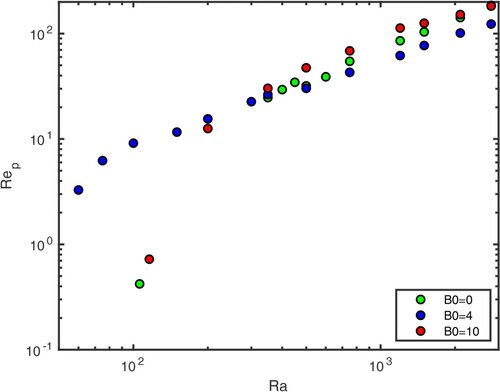
The magnetic Prandtl number is set to 1 in all our simulations, so the magnetic Reynolds number is equal to the Reynolds number. In self-sustained spherical convective dynamos, the magnetic Reynolds numbers (based on the total velocity) needs to be greater than approximately 40 for dynamo action (Christensen and Aubert Citation2006). This is verified in our simulations with
, where the dynamo onsets at
with a Reynolds number based on the total velocity of 73 and
. Since the Reynolds number is essentially similar for all
at a given
, we might consider that cases with
for
have magnetic Reynolds numbers that are large enough for dynamo action, so these solutions might behave essentially as dynamo solutions. This point will be explored in more detail in section 5.
To study the evolution of the columnar structure of the flow with , we estimate the variations of the axial vorticity along z using the measure of the columnarity
proposed by Soderlund et al. (Citation2012).
is based on the non-axisymmetric vorticity
and defined as
(23)
(23)
where
denotes the average in the axial direction. The integral is evaluated as a sum on a discrete finite grid, where the summation is made over cylindrical radius s and ϕ outside the tangent cylinder. This measure is calculated from taking the time average of
from various data snapshots. Figure (a) shows
as a function of
for the same parameters as figure . The values of
near the onset of convection are consistent with our observations in section 3, i.e. the flow at
(
) is less (more) z-invariant than for
. Soderlund et al. considered that the columnar structure breaks down when
. By this definition, the columnar flows first breaks down for
for
. The degradation of the columnarity occurs later for
and 10.
Figure 6. (a) Columnarity and (b) relative helicity as a function of for
. Both quantities have been time-averaged; the vertical bars shows the standard deviation. (Colour online)
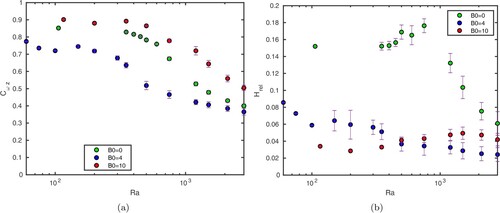
Examples of the 3D structure of the flow are shown in figure for . As expected, the columnarity has visibly broken down for
, but the flow remains columnar to a good degree for
and
. In this latter case, the flow displays quasi-2D sheet-like structures. Convection in this case is heterogeneous with quiescent regions located between the pair of intense radial jets. This sheet-like structure is still noticeable for higher values of
but becomes less uniform between
and
.
Figure 7. Isosurfaces of for (a)
, (b)
, and (c)
at
and
. The red and blue surfaces correspond to isosurfaces at ±20
of the maximum value of
respectively. (Colour online)

To further characterise the flow structure, we measure the kinetic helicity, which describes the spatial correlation between the components of the velocity and vorticity and is defined as
(24)
(24)
The helicity is often thought to be essential to the generation of large-scale magnetic fields (Olson et al. Citation1999, Sreenivasan and Jones Citation2011, Moffatt and Dormy Citation2019) and is therefore an interesting measure to assess the dynamo capability of the flow. Since we study the evolution of the flow with varying
, we use the relative helicity defined as (Olson et al. Citation1999)
(25)
(25)
where
corresponds to the average in the northern or southern hemispheres. Similarly to
, the measure is calculated from taking the time average from different data snapshots.
is negative (positive) in the northern (southern) hemispheres (Olson et al. Citation1999), so we average the absolute value of the two hemispheres. Figure (b) shows
as a function of
. For
, the relative helicity is approximately constant for non-magnetic solutions (
). There is a small increase in the helicity after the onset of dynamo action, while the saturated field remains weak (for
, where
; see section 5); but for higher
the helicity decreases significantly. After the columnarity breaks down, the time-averaged helicity in each of the two hemispheres remains approximately equal in absolute value. Around 50
of the relative helicity is produced by the correlation of the z-components,
. This percentage decreases slightly at the highest values of
, coinciding with the decrease in columnarity. Although the correlation of the z-components is always the largest contributor to the relative helicity, the dominance of the z-components is not as great as might naively be expected. In their asymptotic (small
) linear magnetoconvection analysis (with an imposed azimuthal field), Sreenivasan and Jones (Citation2011) note that the contributions from
and
are equal. Nevertheless some authors (e.g. Soderlund et al. Citation2012) concentrate on the “axial helicity”,
; and indeed, the variations in this quantity are informative. In the presence of an imposed axial field (for
and 10), the correlation between
and
is poor, and the values of the relative helicity are always small. One possible consequence is that these flows would be inefficient for the generation of large-scale magnetic fields (in the absence of the imposed field). This is in contrast to the conclusions of Sreenivasan and Jones (Citation2011), who found enhanced correlation of
and
(and thus enhanced helicity), from calculations with no imposed field, and also from linear magnetoconvection analysis with an imposed azimuthal field. (Most of their calculations used stress-free boundary conditions, where this effect is stronger; but the effect is also present with no-slip conditions, as in the calculations presented here.) They note the effect as stronger for solutions of dipolar symmetry (i.e.
antisymmetric with respect to reflection in the equator), and argue that this effect may explain the dominance of this symmetry for planetary dynamos. Our imposed vertical field has this equatorial symmetry, but the Lorentz force produced by magnetoconvection in its presence clearly does not enhance the vertical flow within convective columns (and hence the helicity) in the same way. In the study of CitationSreenivasan and Jones, the Lorentz force was dominated by
, which is zero near the equator so cannot balance the buoyancy force there. The Coriolis force must therefore balance the buoyancy force near the equator, meaning that the z derivative of
cannot be zero there, giving rise to coherent axial flows along the columns. In our case the Lorentz force is dominated by
, so the buoyancy and Lorentz forces are able to balance near the equator.
Figure shows the spectra of the kinetic energy with respect to the spherical harmonic degree and order for selected Rayleigh numbers. For and 10, the peak of the spectra in m always remains close to their respective critical mode at the onset of convection. For
, there is no drastic change in the spectra for the non-magnetic (
) and dynamo (
) cases, except for a slight shift of the dominant m towards smaller values. For
, the peak is broader, even close to onset, and the energy is increasingly transferred to smaller azimuthal wavenumbers for increasing
.
Figure 8. Spectra of the kinetic energy with respect to the spherical harmonic degree l (left) and order m (right) for . The spectra are time-averaged. (a)
. (b)
and (c)
. (Colour online)
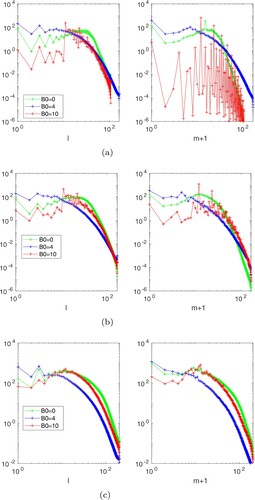
Finally, we conclude this section by looking at the activity inside the tangent cylinder. Convection inside the tangent cylinder onsets when for
. The convection begins at the edge of the tangent cylinder, encroaching from the convection flows in the rest of the shell, before spreading to all latitudes as
increases. The delay of the convection onset inside the tangent cylinder is well-documented in studies of non-magnetic convection (Jones Citation2015) and is caused by the hindering effect of rotation on the linear onset, which is more pronounced towards the poles, where the direction of gravity and the rotation axis are aligned. For
, the convection onsets inside the tangent cylinder earlier than for
(when
); in this case, the presence of both rotation and an imposed field with Elsasser number of order unity is favourable to convection, similarly to the situation outside the tangent cylinder. For
, convection has not occurred inside the tangent cylinder for the highest values of
that we have considered (
). This delay is also expected from results of linear magnetoconvection in plane layer geometry with no rotation or high Elsasser number (Chandrasekhar Citation1961): analogously to the rotating case, the hindering effect of the magnetic field on the convection onset is more pronounced towards the poles when the direction of the imposed field is aligned with the direction of gravity.
4.2. Efficiency of the heat transfer
We now study whether the changes to the 3D structure of the radial velocity for varying affect the efficiency of the heat transfer. We calculate the convective heat flux as
(26)
(26)
where the overbar denotes an azimuthal average. Contour plots of
are shown in figure for
near the onset of convection. Note that these cases are not exactly located at the same
, so we compare the shape of the contours rather than the amplitude of
, and check that our observations remain valid for varying
around these values.
occupies a wider region around the equatorial plane for
than for both
and 10. The Lorentz force partially offsets the Coriolis force in this region (figure ), favouring more vigorous radial flow there.
To measure the improved convective heat transfer in the presence of the imposed field, we look at the evolution of the Nusselt number (defined in equation (Equation14(14)
(14) )) with
in figure .
is approximately 2 orders of magnitude larger near the onset for
than for
and 10, so the efficiency of the convection is greatly improved near onset. As
increases to values greater than 1000, the three cases tend to similar values of
. (Note that this is despite the slightly smaller
values noted for
at high
; i.e. notwithstanding the relatively lower
, the
flow remains efficient at transferring heat.) This is somewhat surprising given the differences observed in the kinetic energy spectra at larger Rayleigh numbers, and in particular, that the flow is dominated by different lengthscales (this remains true at our largest Rayleigh number). This shows that global diagnostics such as
and
do not fully capture the significant differences observed in the flow at large
. In all cases, the measure of columnarity indicates that the columnar structure has nearly broken down for these Rayleigh numbers for all three
, which could allow equally vigorous convection in all 3 cases. There has been considerable discussion of the variation of the heat flow in simulations (and experiments), and on its scaling with varying
,
and
(see Jones Citation2015, for a review and for references).
4.3. Zonal flow
Dynamo simulations tend to have relatively weak zonal (i.e. axisymmetric azimuthal) flows compared with non-magnetic convection simulations (Aubert Citation2005), unless heterogeneous boundary conditions are used (Aubert et al. Citation2013). This is caused by the action of the Lorentz force to prevent the shearing of the poloidal field. We assess how the presence of an imposed axial magnetic field affects this behaviour. Figure shows the ratio of the kinetic energy of the zonal flows to the total kinetic energy as a function of . For
, the zonal flow amplitude is visibly reduced when the dynamo starts at
, as expected from previous dynamo studies. This ratio is much stronger for
than for the other cases, reaching up to
for
. The strong axial field for
largely suppresses zonal flows, whose energy remains around
only of the total kinetic energy.
Figure 11. Ratio of the kinetic energy of the zonal flows to the total kinetic energy as a function of for
. (Colour online)
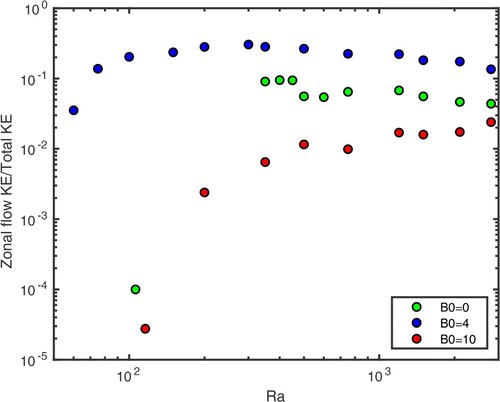
Figure shows a meridional slice of the zonal flow for the case and
. The zonal flow is retrograde near the inner core and prograde near the outer boundary, which is a similar to the pattern observed in non-magnetic rotating spherical convection at moderate
(Christensen Citation2002). The zonal flow has a strong degree of axial dependence in the region of the convective columns, with the largest amplitude near the equatorial region. Ferraro's law of isorotation (Ferraro Citation1937) states that, in the limit of high electrical conductivity (high
), the field lines of the time-averaged axisymmetric poloidal field lines and the isocontours of the time-averaged angular velocity,
, adjust to become aligned, thereby minimising the production of an azimuthal magnetic field via an omega effect (see e.g. Roberts Citation2015). To check the validity of Ferraro's law in our simulations, we superpose the axisymmetric poloidal magnetic field lines in figure . While the poloidal field remains largely directed along z, the z-dependence of the zonal flow means that the isocontours of the zonal flow cross the poloidal field lines around the mid-latitudes. This is at odds with Ferraro's law, but is not unexpected for a fluid of finite electrical conductivity.
Figure 12. Meridional slice of the zonal flow (colour) and field lines of the axisymmetric poloidal field (black lines) for ,
and
. The zonal flow and the poloidal field have been time-averaged. (Colour online)
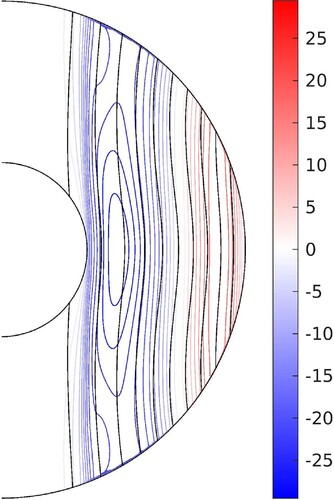
The presence of strong zonal flows for is surprising because the convective columns near the onset of convection do not have a tilt as for
. In the non-magnetic case, the column tilt produces the correlation between radial and azimuthal velocities, leading to significant Reynolds stresses that generate the zonal flows (Busse and Hood Citation1982). We therefore anticipate that the Reynolds stresses are not the primary source for the zonal flows for
. To determine the sources and sinks of the zonal kinetic energy for
, we examine the power budget for the zonal flow, following Aubert (Citation2005). To do so, we multiply the azimuthal average of the ϕ-component of the Navier-Stokes equation (Equation1
(1)
(1) ) by
to obtain
(27)
(27)
where
(28)
(28)
(29)
(29)
(30)
(30)
(31)
(31)
Figure shows the time average of each of these terms in a meridional slice for the case
and
. The power budget is dominated by the contributions from the Coriolis and Lorentz terms, which nearly balance each other, with the Lorentz term acting mainly as a sink near the equatorial region and a source towards mid-latitude. The contribution from the Reynolds stresses is small and acts as a sink around the tangent cylinder and a source at larger cylindrical radius, producing a mostly invariant pattern along z (and opposing the residual of
). The viscous term is a sink term in most of the domain, especially in the vicinity of the tangent cylinder and in the boundary layers (which have been excluded from figure to highlight the dynamics in the bulk). Overall, the main sources of the zonal flow are the Coriolis and Lorentz forces, with contributions that are spatially-dependent. To complete the description of the source terms of the zonal flow, we analyse the terms in the thermal wind equation. The thermal wind equation is obtained by taking the azimuthal average of the ϕ-component of the curl of Navier-Stokes equation (Equation1
(1)
(1) ) (e.g. Aubert Citation2005). Retaining only the Coriolis, buoyancy and Lorentz terms, we obtain
(32)
(32)
Figure shows the time average of each term in this equation for
and
. The magnetic wind (driven by the Lorentz term) nearly balances the thermal wind (driven by the buoyancy term). The sum of the two terms is shown in plot (d) for comparison with the z-gradient of
shown in plot (a). The two plots are nearly identical, which indicates that the viscous and nonlinear inertial terms only play a minor role in the balance. The thermal wind is stronger near the equatorial plane, while the magnetic wind is stronger close to the outer boundary. The magnetic wind is mainly due to the interaction of the magnetic perturbations with the imposed field and opposes the shearing of the poloidal magnetic field lines by the z-gradients of the zonal flow. The thermal wind is strong in this case because the convection is efficient at transporting heat as described in section 4.2, which creates strong latitudinal variations of the temperature. The enhanced zonal flows observed for
(shown in figure ) are therefore indirectly produced by the enhanced convective transport.
Figure 13. Time averages of the terms in the power budget of the zonal flow in a meridional slice for the same case as in figure . Ten radial points have been excluded at the inner and outer boundaries. (Colour online)
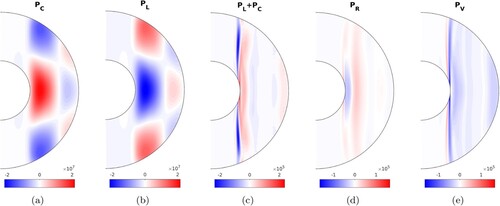
Sakuraba (Citation2007) studied a case of magnetoconvection with imposed axial field for ,
and
(where we have rescaled their parameters to match our definitions). They also observe the formation of thermal-wind driven zonal flows that are retrograde near the inner core. This is despite the different choice of thermal boundary conditions, with CitationSakuraba using mixed boundaries (fixed temperature at the inner core
and zero flux at
). The shape of the isotherms are very sensitive to the choice of thermal boundary conditions, but the same choice of inner boundary condition seems to result in similar behaviour here, regardless of the differing outer condition.
Figure 14. Time averages of the terms in the thermal wind equation in a meridional slice for the same case as in figure . Plot (d) shows the sum of the buoyancy term and the Lorentz term. All the panels have the same colorbar. Ten radial points have been excluded at the inner and outer boundaries. (a) . (b)
. (c)
and (d) Residual. (Colour online)
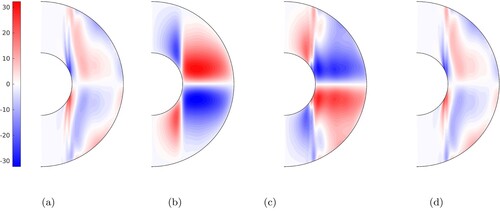
5. Generation of the magnetic field
5.1. Evolution of the magnetic energy with 

In this section, we study the characteristics of the magnetic field induced by the flow for varying and
. We first study the evolution of the strength of the magnetic field.
Figure (a) shows the Elsasser number (see definition in section 2.3) as a function of
. For
, the Elsasser number increases monotonically up to values greater than 1 for
. For
, the magnetic field always remains dominated by the dipole in the range of Rayleigh numbers investigated here, which goes up to
. Higher values of
are required to enter the multipolar regime (Christensen and Aubert Citation2006). For
, the multipolar regime is entered at smaller values of
(
), at which point the Elsasser number decreases below unity. When
,
drops towards
(
) near the onset of convection, so the solution branch is continuous at
. For
, Λ reaches a local maximum for
, before increasing monotonically for
. This local maximum corresponds to the kink in the plot of
observed in section 4.1, and is the result of a change of branch between
and 150. For
, Λ increases steadily after the onset of convection.
Figure 15. (a) Elsasser number , (b) ratio
, and (c) squared Alfvén number
(see definition (Equation12
(12)
(12) )), as a function of
for
. (Colour online)
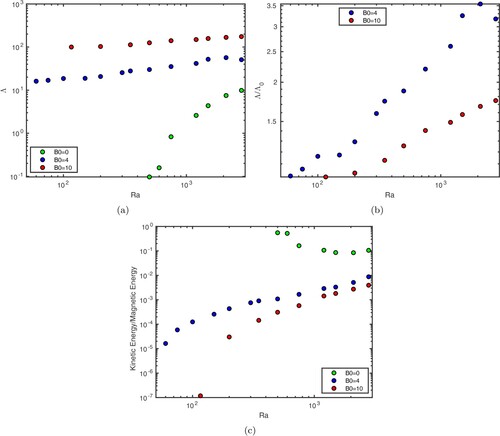
Figure (b) shows the ratio of as a function of
. The induced field exceeds the imposed field (
) for
at
. For
, this situation has not yet occurred, although the amplitude of the induced field gets increasingly close to the imposed field:
for our largest Rayleigh number. For both
and 10, there are no obvious changes in the evolution of
around
, where the magnetic Reynolds number reaches the value of the dynamo threshold in the absence of imposed field.
Figure (c) shows the evolution of the squared Alfvén number, , the ratio of the kinetic to magnetic energies as defined in section 2.3 (equation (Equation12
(12)
(12) )). For reference,
is thought to be of the order of
in the Earth's core (Aubert et al. Citation2017). For
,
decreases with increasing
, but always remains fairly large, never falling below 0.1. For
and 10,
is much smaller, of the order of
and
close to the onset respectively. However, in both cases,
increases with
up to approximately
and
. The kinetic energy therefore increases more rapidly than the magnetic energy in the magnetoconvection case, contrary to the dynamo case.
Note that we did not observe notably large temporal fluctuations of the kinetic and magnetic energies in any of our simulations. For instance, at , the kinetic energy fluctuates by approximately
around the mean value, while the fluctuations of the magnetic energy tend to be smaller at larger
(around
of the mean value for
and
for
). Figure (a) shows the evolution of the toroidal ratio i.e. the ratio of the toroidal magnetic energy to the total magnetic energy. For
, the toroidal ratio is approximately 0.5 for all
. For
, the toroidal ratio is much smaller: simulations at
slowly increases above 0.01 up to around 0.3, while for
, the toroidal ratio is less than
near the onset of convection and increases up to
for the largest
. The poloidal component therefore largely dominates the magnetic field in magnetoconvection with an imposed axial field, while the magnetic energy is equally distributed between poloidal and toroidal components in our dynamo simulations. This observation is consistent with the results of Sakuraba and Kono (Citation2000).
Figure (b) shows the evolution of the ratio of the axisymmetric toroidal to the toroidal magnetic energies. For , this ratio remains constant around 0.15 for the highest
. For
, approximately
of the toroidal magnetic energy is contained in the axisymmetric mode around
. This observation is consistent with the formation of strong zonal flows in this case, as the zonal flows distorts the poloidal magnetic field to produce the axisymmetric toroidal field via an omega effect. The zonal flows are relatively weaker at larger
, so the axisymmetric toroidal field weakens compared to the total toroidal field then. For
, the axisymmetric toroidal field is weak, especially at small
, which is consistent with the weak zonal flows observed in this case.
Figure 16. (a) Ratio of the toroidal magnetic energy to the total magnetic energy and (b) ratio of the axisymmetric toroidal to the toroidal magnetic energies as a function of for
. (Colour online)
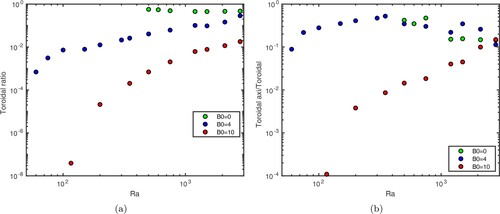
To conclude this section, we study the partition of the poloidal magnetic energy between dipolar and multipolar components. Figure shows the spectra of the time-averaged poloidal magnetic energy for fixed Rayleigh numbers. The dominant degree is l = 1 even for the highest values of , indicating the dipolar nature of the field. As mentioned earlier, for
at
, we found that the field becomes multipolar for
, but no multipolar regime was found for
for Rayleigh number up to
. Christensen and Aubert (Citation2006) found that convective dynamos produce multipolar fields when the local Rossby number (
with
is a typical flow lengthscale) is greater than 0.1. In our simulations,
for
and
, so we expect that higher values of
are required to enter the multipolar regime in this case, despite
being less than 0.5. The cases with
show a gradual degradation of the relative dipole strength when
increases, which is more pronounced for
. However, the field remains overwhelmingly dipolar even at large
where the induced field is of the same order of magnitude as the imposed field. In these cases too,
is still less than 0.1.
Figure 17. Spectra of the poloidal magnetic energy with respect to the spherical harmonic degree l (left) and order m (right) for . The coloured circles on each vertical axis represent the poloidal energy of the imposed magnetic field itself. The spectra are time-averaged. (a)
. (b)
and (c)
. (Colour online)
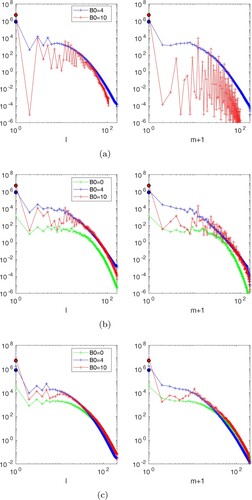
5.2. Morphology of the magnetic field
We now analyse the morphology of the magnetic field, starting from the axisymmetric magnetic field. Figure shows meridional slices of the axisymmetric azimuthal magnetic field and the poloidal magnetic field lines. In the magnetoconvective cases, the poloidal field lines remain largely z-invariant, indicating that the imposed field is relatively unperturbed by the induced poloidal field, with the most significant variations observed at larger . For
and
, the induced field has a larger amplitude than the imposed field (see figure (b)) but, even then, the magnetic field largely retains the shape of the imposed magnetic field. For
, the azimuthal field consists of a single ring located outside the tangent cylinder and of opposite sign in each hemisphere. For
, the azimuthal field can be related to the zonal flow shown in figure via an omega effect. Only weak azimuthal field is present inside the tangent cylinder, which is consistent with the absence of zonal flow there (and despite the presence of convection for
). By contrast, for
, a strong azimuthal field is produced on the tangent cylinder and diffuses inwards (there is no convection inside the tangent cylinder for
in this case). For
, the azimuthal field is very weak, even for higher values of
, and multiple patches are seen in both hemispheres.
Figure 18. Meridional slices of the axisymmetric azimuthal field (colour) and field lines of the axisymmetric poloidal field (black lines) for . The magnetic field has been time-averaged in all cases. (a)
,
. (b)
,
. (c)
,
. (d)
,
. (e)
,
. (f)
,
and (g)
,
.
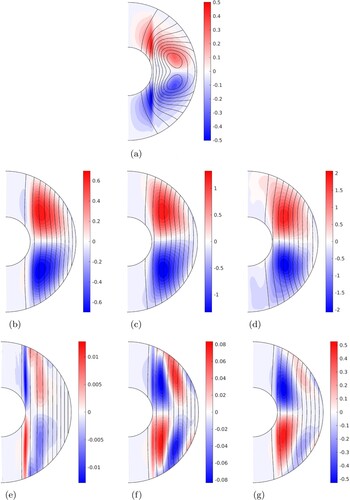
To determine whether the induced magnetic field reinforces or diminishes the imposed magnetic field, we plot in figure the induced component of the axisymmetric axial magnetic field, . Only the northern hemisphere is shown as
is largely symmetric about the equator. For
, the axial magnetic field is strongest at higher latitudes, and of the sense to reinforce the imposed field. (The sense for
is coincidental, as the opposite sense is an equally valid solution.) In the equatorial regions near the outer boundary (and in the exterior), the induced dipole field results in locally negative induced
values; these are always weaker than the imposed field, however, so the total axisymmetric
is always positive. For
, there is a significant octopole component of induced field close to onset, resulting in opposite polarity fields near the equator. At
, the induced field inside the tangent cylinder is a significant fraction of the imposed field. Overall, for both
and 10, the induced axial dipole therefore reinforces the imposed field.
Figure 19. Meridional slices of the induced axisymmetric axial magnetic field, , for
. The rows show cases at
and 10 from top to bottom. The field has been time-averaged for
. (a)
. (b)
. (c)
. (d)
and (e)
.

Figure shows equatorial slices of the induced axial magnetic field (i.e. ) in the equatorial plane, superimposed on the axial vorticity. For
, we show the nearest case to the dynamo onset,
. In this case, the maximum of
is located within the anticyclones, which is a familiar feature of convective dynamos (e.g. Jones Citation2011). In the magnetoconvective cases for Rayleigh numbers close to onset, the axial magnetic field is concentrated between cyclones and anticyclones, with regions of positive induced axial fields (which reinforce the imposed field) correlated with cold (inward) radial flow. At larger Rayleigh numbers (
) however, the axial magnetic field is concentrated in the anticyclones in the equatorial plane, similarly to the dynamo case. This observation is in agreement with the study of Sakuraba and Kono (Citation2000) for
, which emphasises that the magnetic flux concentration inside anticyclones leads to an asymmetry between cyclones and anticyclones with enlarged anticyclones. They argue that the magnetic confinement is due to convergent flows towards the core of the anticyclones in the equatorial plane that compensate the Ekman pumping at the outer boundary.
Figure 20. Contours of the induced axial field (black lines) superimposed onto the axial vorticity (colour) in a quarter of the equatorial plane for cases at
. For the induced
, the solid and dashed lines denote positive and negative values respectively. The case for
(a) is near the dynamo onset. Cases for
are near the onset of convection (b)–(c) and for
(d)–(e). Ten radial points have been excluded at the inner and outer boundaries to highlight the axial vorticity in the bulk of the fluid. (a)
,
. (b)
,
. (c)
,
. (d)
,
and (e)
,
. (Colour online)
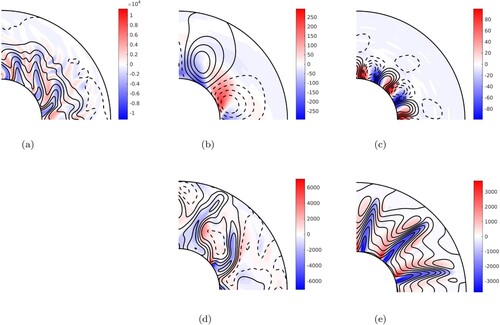
Figure 21. R.m.s. value of as a function of m for the first 20 spherical harmonics orders. The red circle at m = 0 on each plot shows the value of
for the induced field only (i.e.
). The values have been time-averaged for
. (a)
,
. (b)
,
. (c)
,
. (d)
,
and (e)
,
. (Colour online)
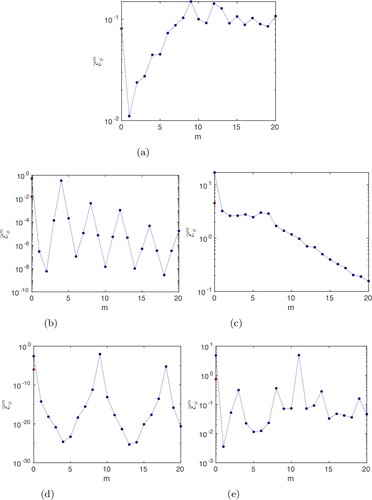
Figure 22. Meridional slices of and
for the same cases as in figure . The chosen values of m for
are noted in the subfigure caption. For the cases with
, the values have been time-averaged. (a)
,
; from left to right:
,
,
,
. (b)
,
; from left to right:
,
,
,
. (c)
,
; from left to right:
,
,
,
. (d)
,
; from left to right:
,
,
,
and (e)
,
; from left to right:
,
,
,
. (Colour online)

5.3. Generation of the axisymmetric poloidal field
In order to determine which lengthscales play a major role in the generation of the axisymmetric poloidal magnetic field, we study the contributions to the electromotive force (e.m.f. ). The equation for the poloidal magnetic component is obtained by taking the dot product of the magnetic induction equation with the vector
,
(33)
(33)
where we have used that
and the
operator isolates the angular part of the Laplacian,
(34)
(34)
Applied to a spherical harmonic
, it gives
. The e.m.f. is
. From equation (Equation33
(33)
(33) ), the axisymmetric poloidal component
is driven by the ϕ-component of the axisymmetric e.m.f.,
. (Specifically, the relevant source term is
.) We decompose
into contributions from individual azimuthal spherical harmonics order m,
(35)
(35)
where the superscript indicates a component of the velocity or magnetic field corresponding to a given m.
Figure shows the r.m.s. value of as a function of m for
for
close to onset and at
. Figure shows the corresponding meridional slices of
for the dominant value(s) of m and also the sum
.
is mainly symmetric about the equator in all cases, so we only show the northern hemisphere. For comparison, we also plot the azimuthal component of the axisymmetric electric current (which is related to the mean e.m.f. via Ohm's law)
(36)
(36)
For
, the largest contribution to the mean e.m.f. is produced by the modes
, all contributing at a similar level until m = 20. The large-scale modes
have relatively weak kinetic energy (see the kinetic energy spectrum in figure (b)), so it is perhaps unsurprising that their contribution to the mean e.m.f. is small. The sum of the mean e.m.f. produced by the modes
is very similar to
, so the small scales corresponding to m>20 only play a minor role in the generation of the axisymmetric poloidal field. In fact, this is true for all the cases shown in figure .
For , the main contribution comes from m = 0 and m = 4 at onset, with m = 4 generating a mean e.m.f. that opposes that of m = 0 (which is largely due to the interaction of the axisymmetric meridional circulation with the imposed field), but cannot entirely match it. The net mean e.m.f. is thus similar to that of m = 0 with a reduced amplitude. It produces a ring of negative
in the equatorial region, topped by a ring of positive
at higher latitudes. Positive (negative) induced
is produced inside (outside) the ring of positive
and vice-versa (see figure ). For
, modes up to m = 8 contribute significantly to
. Here again the non-axisymmetric modes generate a mean e.m.f. in opposition to that of m = 0. The net e.m.f. now produces mainly a ring of positive
whose maximum is located at mid-latitudes near the outer boundary. As a result, the induced
is positive in most of the domain and only negative near the outer boundary at low latitudes. For
away from the onset, the large-scale non-axisymmetric modes that dominate the kinetic energy spectrum (figure (b)) therefore largely contribute to the generation of an induced field that reinforces the imposed field.
At near onset, the dominant contribution comes from m = 9 (which dominates the kinetic energy spectrum). The resulting
is positive and contained in a narrow band outside the tangent cylinder, which corresponds to the location of the columnar flow (see figures and ). Accordingly, the induced
is mainly positive inside the tangent cylinder and negative outside. At higher
, the dominant non-axisymmetric mode is now m = 11 (also the dominant non-axisymmetric mode of the kinetic energy spectrum), with m = 0 contributing at a similar level. These two modes produce e.m.f. that are in opposition in most of the domain. As the flow structure extends further in cylindrical radius when
increases (see figure ), the resulting positive
now fills most of the domain outside the tangent cylinder, producing a positive induced
throughout most of the domain. Interestingly, the net mean e.m.f. is fairly similar for
and
at
(hence similar induced
in figure ), although the contributions from individual modes are very different. This highlights a notable difference in field generation mechanisms between
and
, although the net outcome in both cases is the production of an axisymmetric poloidal field reinforcing the imposed field in the interior.
6. Discussion
We have studied the effects of an imposed axial magnetic field on rotating spherical convection at onset and for supercritical values of the Rayleigh number. Our parameter survey included both
and
, for a range of values of
varying from 1 to 50, with fixed
, and with fixed temperature, no-slip, and electrically insulating boundary conditions.
We found significant changes in the onset of convection when (where
corresponds to an Elsasser number of unity), with a decrease in the critical Rayleigh number
and azimuthal wavenumber
that is more pronounced at small
. The critical Rayleigh number increases again for larger values of
, becoming independent of the choice of
. The structure of the flow at onset is mainly columnar, regardless of the choice of
. The primary force balance gradually changes as
increases, and the Lorentz force becomes one of the dominant forces balancing the Coriolis and buoyancy forces. Interestingly, we find that the primary force balance varies locally: for
, the buoyancy and Lorentz forces balance in the equatorial region, but the balance is mainly between the Coriolis and Lorentz forces near the outer surface. The change in the force balance is evident in the wave propagation, which is prograde and matches the frequency of thermal Rossby waves for
, and subsequently slows down as
increases, until reversing direction at
for small
.
For higher values of , the columnar flows break down, with the earliest collapse seen for
. In this case, more efficient transport of heat is seen in the equatorial region, as the Lorentz force offsets the Coriolis force here. The improved convective heat transfer leads to strong latitudinal variations of the temperature resulting in a strong thermal wind. This in turn has led to zonal flows in our magnetoconvective simulations, despite the equivalent dynamo simulations normally having weak zonal flows. These zonal flows can distort the poloidal component of the magnetic field, to produce a stronger axisymmetric toroidal field. For larger values of
, zonal flows are suppressed by the stronger axial field. Yadav et al. (Citation2016b) found that the presence of dominant zonal flows (and hence large shear) in non-magnetic convection simulations reduces the efficiency of the convective heat transfer compared with dynamo cases, where the zonal flows are drastically reduced. This occurs when using stress-free boundary conditions, which favour the development of large zonal flows. Here, on the contrary, we have a strong thermal wind combined with efficient heat transfer. However the zonal flows are never dominant over the convective flows in our simulations because the zonal flow amplitude is limited by the use of no-slip boundaries. Additionally, Yadav et al. (Citation2016b) found that no-slip dynamo simulations have significantly improved heat transfer compared with the non-magnetic cases when the Elsasser number of the self-sustained magnetic field is order unity, which is consistent with our results.
Near onset, the induced magnetic field generated by magnetoconvection is much smaller than the imposed field. The existence of subcritical behaviour, where a convective solution that is obtained by switching off the imposed field exists at the same parameters as the trivial conducting state, would require that the induced magnetic field is sufficiently strong to modify the flow effectively. Here we found that the field needs to be order unity to significantly influence the flow, so we expect that subcritical solutions would be difficult to maintain near onset. Indeed, we carried out multiple attempts to maintain convective dynamos below the onset of convection by gradually reducing the imposed field, but all were unsuccessful. However, for , the induced field exceeds the imposed field for Rayleigh numbers approximately ten times critical. The induced field reinforces the imposed field in most of the domain, and the magnetic field largely retains the z-invariance of the imposed field, even at the largest Rayleigh numbers. The magnetically-modified flows are therefore able to generate a large-scale field with an intensity and morphology comparable to the imposed field. As a result, the intermittent behaviour observed in the planar dynamo simulations of Stellmach and Hansen (Citation2004), Cooper et al. (Citation2020) and suggested by the magnetoconvection results of Zhang and Gubbins (Citation2000a, Citation2000b) might be avoided in this case. Additionally, hysteretic behaviour at high Rayleigh numbers might be possible: for Rayleigh numbers greater than the value required for the dynamo onset, a “strong” dynamo solution (obtained by switching off the imposed field) might exist at the same parameters as a “weak” dynamo solution (obtained by small initial perturbation). This was indeed observed by Sarson et al. (Citation1997, Citation1999) and Sakuraba and Kono (Citation2000) in this regime. We have also attempted to obtain hysteresis for
and
, but this has been unfruitful so far and will require further study.
The large-scale field generation is greatly affected by changes in the imposed field strength. In our dynamo simulations at , the axisymmetric poloidal field is generated by the “small-scale” convective flows that are relatively unaffected by the Lorentz force (corresponding to azimuthal orders
for
, but we would expect these scales to become smaller for decreasing
based on linear stability). A clear change occurs for
, where only the large-scale flows (with m<8) are significant in the production of the axisymmetric poloidal field. These scales carry most of the kinetic energy and are greatly affected by the Lorentz force. Notably, they lack attributes that are sometimes associated with the generation of axial dipoles (e.g. Olson et al. Citation1999, Sreenivasan and Jones Citation2011): their relative kinetic helicity and columnarity are significantly reduced compared with cases at
. Another change occurs at larger
(
), where a single non-axisymmetric mode is largely responsible for the production of the axisymmetric poloidal field together with contributions from the axisymmetric mode (at least up to
, where this mode remains close to the value of the dominant wavenumber at onset). Our simulations are performed at moderate values of
, so the distinction between “small” and “large” scales is not strongly marked, but we would expect this distinction to become very pronounced in planetary core conditions at smaller
.
Magnetoconvection calculations help to elucidate the mechanisms for the production of magnetic fields in planets embedded in external fields of various strengths (e.g. the Jovian satellites and some exoplanets), as well as general aspects of field-generation in a strong-field regime. Our calculations complement the more prevalent studies of magnetoconvection with an imposed toroidal field. Some important differences are noted – including the imposed field strength required to markedly affect the flow (Fearn Citation1979) and the effect of the imposed axial field to reduce the relative kinetic helicity (e.g. see Sreenivasan and Jones Citation2011), with possibly significant implications for magnetic field generation – which warrant further work to elaborate to what extent the effects noted here rely on the imposed axial field geometry. A disadvantage of using a uniform magnetic field is that the whole domain is subject to the presence of the ambient field, whereas recent dynamo simulations show that the magnetic field is heterogeneous within the bulk of the domain (Schaeffer et al. Citation2017). The presence of magnetic-free regions have not been considered here, but could be the subject of future magnetoconvection studies. Other work could further investigate different boundary conditions or parameters, or imposing an axial field that is not uniform (Sreenivasan and Gopinath Citation2017).
Work is currently in progress to extend this study to variable , for values both smaller and larger than the
case considered here. The case
is relevant to planetary interiors (where
, based on molecular diffusivities); but as noted by Dormy (Citation2016), the case
may allow calculations at relatively high
to attain a strong-field solution branch, more relevant to the expected magnetostrophic balance, than the weak-field and multipolar solutions found here for
(when considering
). The combined effects of varying
and
are therefore of considerable interest for understanding planetary dynamos.
Acknowledgements
This research made use of the Rocket High Performance Computing service at Newcastle University and the DiRAC Data Intensive service at Leicester, operated by the University of Leicester IT Services, which forms part of the STFC DiRAC HPC Facility (www.dirac.ac.uk). DiRAC is part of the National e-Infrastructure. We thank the reviewers and editor whose comments helped clarify and improve the manuscript.
Disclosure statement
No potential conflict of interest was reported by the author(s).
Additional information
Funding
References
- Aubert, J., Steady zonal flows in spherical shell dynamos. J. Fluid Mech. 2005, 542, 53–67.
- Aubert, J., Aurnou, J. and Wicht, J., The magnetic structure of convection-driven numerical dynamos. Geophys. J. Int. 2008, 172, 945–956.
- Aubert, J., Finlay, C.C. and Fournier, A., Bottom-up control of geomagnetic secular variation by the Earth's inner core. Nature 2013, 502, 219–223.
- Aubert, J., Gastine, T. and Fournier, A., Spherical convective dynamos in the rapidly rotating asymptotic regime. J. Fluid Mech. 2017, 813, 558–593.
- Busse, F.H. and Hood, L.L., Differential rotation driven by convection in a rapidly rotating annulus. Geophys. Astrophys. Fluid Dyn. 1982, 21, 59–74.
- Cardin, P. and Olson, P., The influence of toroidal magnetic field on thermal convection in the core. Earth Planet. Sci. Lett. 1995, 132, 167–181.
- Chandrasekhar, S., Hydrodynamic and Hydromagnetic Stability, 1961 (Oxford: Oxford University Press).
- Cheng, J.S. and Aurnou, J.M., Tests of diffusion-free scaling behaviors in numerical dynamo datasets. Earth Planet. Sci. Lett. 2016, 436, 121–129.
- Christensen, U.R., Zonal flow driven by strongly supercritical convection in rotating spherical shells. J. Fluid Mech. 2002, 470, 115–133.
- Christensen, U.R. and Aubert, J., Scaling properties of convection driven dynamos in rotating spherical shells and application to planetary magnetic fields. Geophys. J. Int. 2006, 166, 97–114.
- Christensen, U.R. and Wicht, J., Numerical dynamo simulations. In Core Dynamics, 2nd ed., edited by P. Olson, Vol. 8 of Treatise on Geophysics, pp. 245–282, 2015 (Elsevier: Amsterdam).
- Christensen, U., Aubert, J., Cardin, P., Dormy, E., Gibbons, S., Glatzmaier, G., Grote, E., Honkura, Y., Jones, C., Kono, M., Matsushima, M., Sakuraba, A., Takahashi, F., Tilgner, A., Wicht, J. and Zhang, K., A numerical dynamo benchmark. Phys. Earth Planet. Inter. 2001, 128, 25–34.
- Cooper, R.G., Bushby, P.J. and Guervilly, C., Subcritical dynamos in rapidly rotating planar convection. Phys. Rev. Fluids 2020, 5, 113702.
- Dormy, E., Strong-field spherical dynamos. J. Fluid Mech. 2016, 789, 500–513.
- Dormy, E., Cardin, P. and Jault, D., MHD flow in a slightly differentially rotating spherical shell, with conducting inner core, in a dipolar magnetic field. Earth Planet. Sci. Lett. 1998, 160, 15–30.
- Dormy, E., Soward, A.M., Jones, C.A., Jault, D. and Cardin, P., The onset of thermal convection in rotating spherical shells. J. Fluid Mech. 2004, 501, 43–70.
- Fearn, D.R., Thermal and magnetic instabilities in a rapidly rotating fluid sphere. Geophys. Astrophys. Fluid Dyn. 1979, 14, 103–126.
- Fearn, D.R., Hydromagnetic waves in a differentially rotating annulus III. The effect of an axial field. Geophys. Astrophys. Fluid Dyn. 1985, 33, 185–197.
- Fearn, D.R. and Weiglhofer, W.S., Magnetic instabilities in rapidly rotating spherical geometries I. From cylinders to spheres. Geophys. Astrophys. Fluid Dyn. 1991a, 56, 185–197.
- Fearn, D.R. and Weiglhofer, W.S., Magnetic instabilities in rapidly rotating spherical geometries II. more realistic fields and resistive instabilities. Geophys. Astrophys. Fluid Dyn. 1991b, 60, 275–294.
- Fearn, D.R. and Weiglhofer, W.S., Magnetic instabilities in rapidly rotating spherical geometries. III. The effect of differential rotation. Geophys. Astrophys. Fluid Dyn. 1992a, 67, 163–184.
- Fearn, D.R. and Weiglhofer, W.S., Resistive instability and the magnetostrophic approximation. Geophys. Astrophys. Fluid Dyn. 1992b, 63, 111–138.
- Ferraro, V.C., The non-uniform rotation of the sun and its magnetic field. Mon. Not. R. Astron. Soc. 1937, 97, 458.
- Finlay, C.C., Waves in the presence of magnetic fields, rotation and convection. In Dynamos, edited by P. Cardin and L.F. Cugliandolo, Vol. 88 of Lecture Notes of the Les Houches Summer School, pp. 403–450, 2008 (Elsevier: Amsterdam).
- Gillet, N., Brito, D., Jault, D. and Nataf, H.C., Experimental and numerical studies of magnetoconvection in a rapidly rotating spherical shell. J. Fluid Mech. 2007, 580, 123–143.
- Gillet, N., Jault, D., Canet, E. and Fournier, A., Fast torsional waves and strong magnetic field within the Earth's core. Nature 2010, 465, 74–77.
- Gómez-Pérez, N. and Wicht, J., Behavior of planetary dynamos under the influence of external magnetic fields: Application to Mercury and Ganymede. Icarus 2010, 209, 53–62.
- Jones, C.A., Planetary magnetic fields and fluid dynamos. Annu. Rev. Fluid Mech. 2011, 43, 583–614.
- Jones, C.A., Thermal and compositional convection in the outer core. In Core Dynamics, 2nd ed., edited by P. Olson, Vol. 8 of Treatise on Geophysics, pp. 115–159, 2015 (Elsevier: Amsterdam).
- King, E.M. and Buffett, B.A., Flow speeds and length scales in geodynamo models: the role of viscosity. Earth Planet. Sci. Lett. 2013, 371, 156–162.
- Moffatt, K. and Dormy, E., Self-Exciting Fluid Dynamos, 2019 (Cambridge: Cambridge University Press).
- Olson, P. and Glatzmaier, G.A., Magnetoconvection in a rotating spherical shell: structure of flow in the outer core. Phys. Earth Planet. Inter. 1995, 92, 109–118.
- Olson, P.L., Christensen, U.R. and Glatzmaier, G.A., Numerical modelling of the geodynamo: mechanisms of field generation and equilibration.. J. Geophys. Res. 1999, 104, 10383–10404.
- Oruba, L. and Dormy, E., Predictive scaling laws for spherical rotating dynamos. Geophys. J. Int. 2014, 198, 828–847.
- Proctor, M.R.E., Convection and magnetoconvection in a rapidly rotating sphere. In Lectures on Solar and Planetary Dynamos, Publications of the Newton Institute, edited by M.R.E. Proctor and A.D. Gilbert, pp. 97–115, 1994 (Cambridge University Press: Cambridge).
- Roberts, P.H., Theory of the geodynamo. In Core Dynamics, 2nd ed., edited by P. Olson, Vol. 8 of Treatise on Geophysics, pp. 57–90, 2015 (Elsevier: Amsterdam).
- Roberts, P.H. and King, E.M., On the genesis of the Earth's magnetism. Rep. Progr. Phys. 2013, 76, 096801.
- Sakuraba, A., Linear magnetoconvection in rotating fluid spheres permeated by a uniform axial magnetic field. Geophys. Astrophys. Fluid Dyn. 2002, 96, 291–318.
- Sakuraba, A., A jet-like structure revealed by a numerical simulation of rotating spherical-shell magnetoconvection. J. Fluid Mech. 2007, 573, 89–104.
- Sakuraba, A. and Kono, M., Effect of a uniform magnetic field on nonlinear magnetoconvection in a rotating fluid spherical shell. Geophys. Astrophys. Fluid Dyn. 2000, 92, 255–287.
- Sarson, G.R., Jones, C.A., Zhang, K. and Schubert, G., Magnetoconvection dynamos and the magnetic fields of Io and Ganymede. Science 1997, 276, 1106–1108.
- Sarson, G.R., Jones, C.A. and Zhang, K., Dynamo action in a uniform ambient field. Phys. Earth Planet. Inter. 1999, 111, 47–68.
- Schaeffer, N., Efficient spherical harmonic transforms aimed at pseudospectral numerical simulations. Geochem. Geophys. Geosyst. 2013, 14, 751–758.
- Schaeffer, N., Jault, D., Nataf, H.C. and Fournier, A., Turbulent geodynamo simulations: a leap towards Earth's core. Geophys. J. Int. 2017, 211, 1–29.
- Soderlund, K.M., King, E.M. and Aurnou, J., The influence of magnetic fields in planetary dynamo models. Earth Planet. Sci. Lett. 2012, 333-334, 9–20.
- Sreenivasan, B. and Gopinath, V., Confinement of rotating convection by a laterally varying magnetic field. J. Fluid Mech. 2017, 822, 590–616.
- Sreenivasan, B. and Jones, C.A., Helicity generation and subcritical behaviour in rapidly rotating dynamos. J. Fluid Mech. 2011, 688, 5–30.
- Stellmach, S. and Hansen, U., Cartesian convection driven dynamos at low Ekman number. Phys. Rev. E 2004, 70, 056312.
- Teed, R.J., Jones, C.A. and Tobias, S.M., The transition to Earth-like torsional oscillations in magnetoconvection simulations. Earth Planet. Sci. Lett. 2015, 419, 22–31.
- Yadav, R., Gastine, T., Christensen, U., Wolk, S.J. and Poppenhaeger, K., Approaching a realistic force balance in geodynamo simulations. Proc. Natl. Acad. Sci. 2016a, 113, 12065–12070.
- Yadav, R.K., Gastine, T., Christensen, U.R., Duarte, L. and Reiners, A., Effect of shear and magnetic field on the heat-transfer efficiency of convection in rotating spherical shells. Geophys. J. Int. 2016b, 204, 1120–1133.
- Zhang, K., Spiralling columnar convection in rapidly rotating spherical fluid shells. J. Fluid Mech. 1992, 236, 535–556.
- Zhang, K., Spherical shell rotating convection in the presence of a toroidal magnetic field. Proc. R. Soc. Lond. A 1995, 448, 245–268.
- Zhang, K. and Fearn, D., How strong is the invisible component of the magnetic field in the Earth's core? Geophys. Res. Lett. 1993, 20, 2083–2086.
- Zhang, K. and Gubbins, D., Is the geodynamo process intrinsically unstable? Geophys. J. Int. 2000a, 140, F1–F4.
- Zhang, K. and Gubbins, D., Scale disparities and magnetohydrodynamics in the Earth's core. Phil. Trans. R. Soc. A 2000b, 358, 899–920.
APPENDICES
Appendix A: Implementation of the externally imposed magnetic field
The magnetic field and electric current density, , are decomposed into poloidal and toroidal components
(A.1)
(A.1)
(A.2)
(A.2)
The poloidal and toroidal scalars of
and
are related as
(A.3)
(A.3)
In the vacuum outside the outer sphere, the electric current density is zero and so
(A.4)
(A.4)
The poloidal scalar is decomposed in spherical harmonics,
(A.5)
(A.5)
Note that g here denotes the external solution, while we will denote the internal solution by p.
implies that
(A.6)
(A.6)
where we used
, with
the angular part of the Laplacian introduced in section 5.3. The solutions are of the form
. Substituting in equation (EquationA.6
(A.6)
(A.6) ) gives
, which has for solutions
(corresponding to external sources) and
(corresponding to internal sources).
We consider the case where an external source at produces a uniform axial field,
(A.7)
(A.7)
The imposed field only has a poloidal component. We denote by H and h the poloidal scalars of the imposed field in real and spectral spaces. The uniform axial field projects onto the spherical harmonics
with the Legendre polynomial
and normalisation constant
:
(A.8)
(A.8)
By definition of the radial component of the field,
, we get
(A.9)
(A.9)
In the vacuum, the solution for the spherical harmonics
is the contribution from the external and internal sources:
(A.10)
(A.10)
where A is a constant. The poloidal scalar and its radial derivative are continuous at
, and so, the boundary condition for the internal solution at
for
is
(A.11)
(A.11)
(A.12)
(A.12)
There are no external sources for all the other spherical harmonics coefficients with
, so the external solution depending on
must have
. For
, the boundary condition for the internal solution at
is then simply
(A.13)
(A.13)
(A.14)
(A.14)
This latter boundary conditions is already implemented in PARODY, so the only required modification to the code is the implementation of the boundary condition (EquationA.12
(A.12)
(A.12) ).
Appendix B: Theoretical frequency of the thermal Rossby waves
To compare the frequency of the waves near the onset of magnetoconvection in our simulations with the expected frequency of thermal Rossby waves at the same azimuthal wavenumber, we use the theoretical values for non-magnetic thermal Rossby waves provided by the asymptotic study of Dormy et al. (Citation2004) in the case of differential heating with and no-slip boundaries. The theoretical values are given by
(B.1)
(B.1)
(B.2)
(B.2)
(B.3)
(B.3)
where we have introduced the relevant factors to match our choice of units and
(B.4)
(B.4)
is the azimuthal wavenumber of the dominant mode in the numerical simulations.
Appendix C: List of simulations
Table C1. Summary of the input and output quantities for the simulations at and
.

